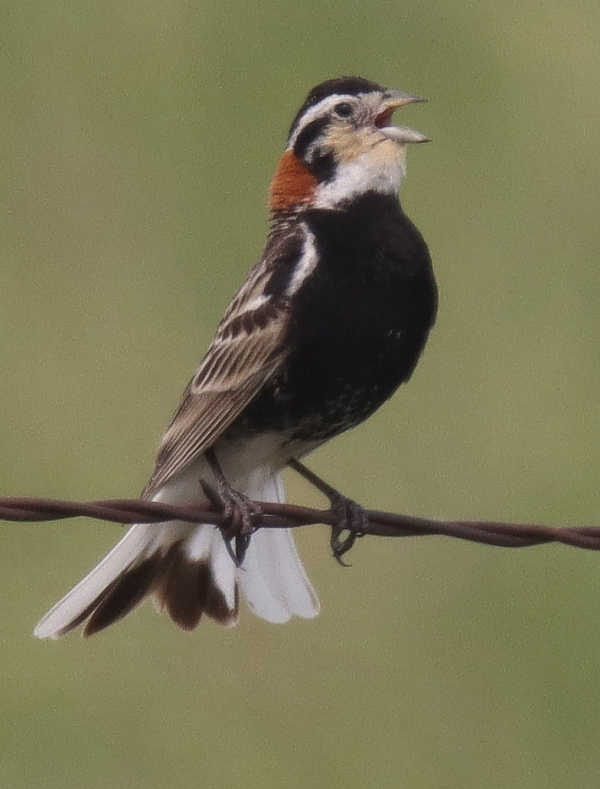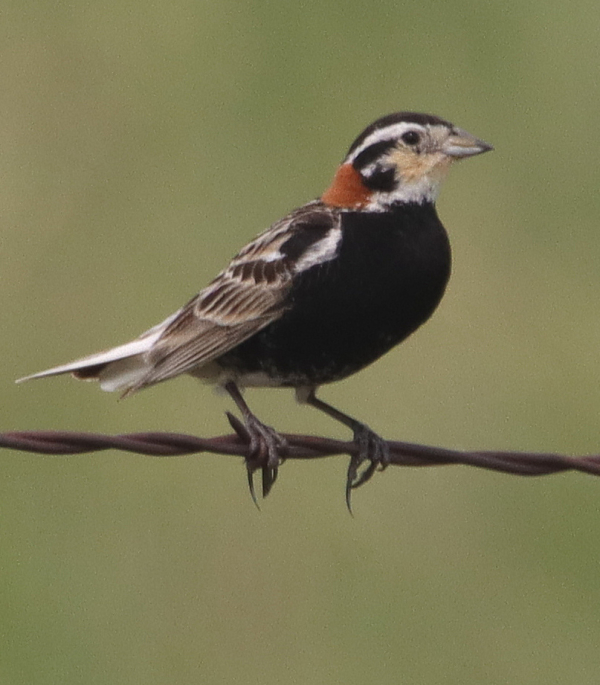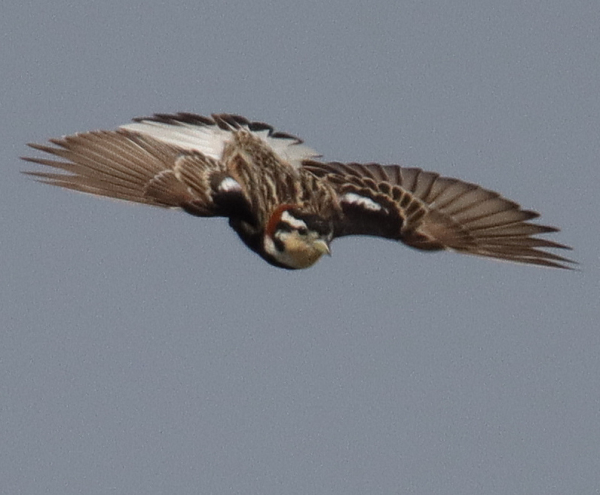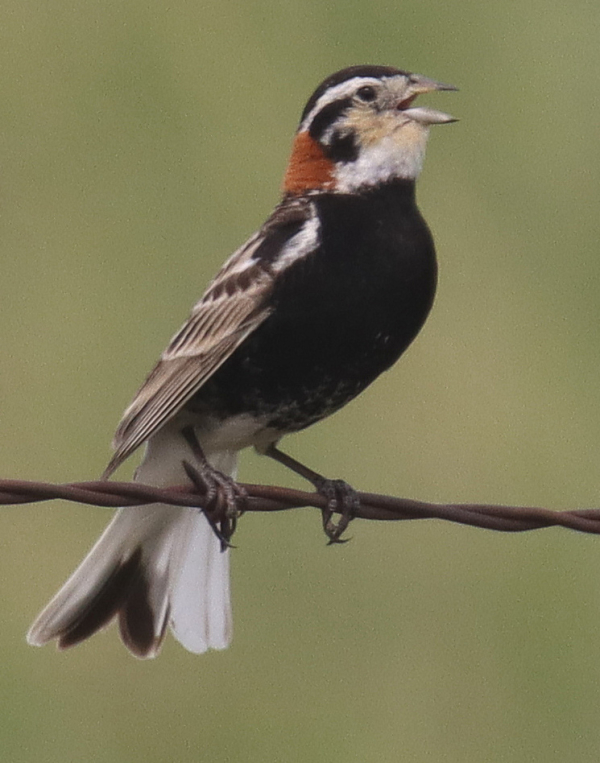
Locating a newly arrived group of Chestnut-collared Longspurs was a thrill in itself, but to have a chance to photograph territorial males for the first time as they sang their tinkering songs was most rewarding (photo tech: 600mm zoom lens, f-7 aperture, 1/1250 shutter speed, ISO 400).
|
Driving down the road, minding my own business, the flight of a tiny bird passing into my line of sight dictated me to slow down, turn around, and see if I could manage to get some photos. That’s the dramatic effect the sighting of a Chestnut-collared Longspur can have on a guy like me, and I was especially glad to see this prairie songbird because it was at the top of my list of birds I hoped to find last Wednesday on my way to Bismarck. Now a rare bird in this area, I saw one a week before in a beautiful prairie area on the north side of Long Lake National Wildlife Refuge, singing in the company of a few Bobolinks, but the longspur turned out to be on the wrong side of the sun to try for a photo, and the bird didn’t remain perched in the open for long.
Wednesday’s sighting was closer to home, in a prairie area about 30 miles to the northwest; a location where I have seen the species before, and that I’ve been checking on weekly during the previous month. That afternoon there were several active Chestnut-collared Longspurs singing from barbed wire perches just above the tallest prairie grasses and flowering plants. They also sang while performing flight displays, and I saw a couple males chasing a female. My impression was that these birds had arrived during the second week of June, a bit after the first Dickcissels, and now they were very active in establishing territories and attracting females. Was this my chance to photograph the birds in action?
Chestnut-collared Longspurs were common nesting birds across the grasslands of the Missouri Coteau until the 1990s, when the local climate became much wetter. As a result the entire population shifted west several hundred miles to drier landscapes, a process true for once common Lark Buntings, Burrowing Owls, and a few other species. Similarly, some bird populations shifted into the area from the east, such as LeConte’s Sparrows. These days I usually only see Chestnut-collared Longspurs in 1 or 2 locations annually, so I was glad to see them in numbers greater than 1 at this little hotspot.

While a wire may not be a preferred perch to photograph birds on, with the name ‘long spur,’ note the length of the lowest nail on the longspur’s foot. So perhaps barbed wire is a fitting perch for this tiny prairie songbird (600mm zoom lens, f-7 aperture, 1/1250 shutter speed, ISO 400).
|
The road I was on isn’t well traveled, so I could pull over without seeing another vehicle for 10 or 15 minutes at a time, and found that the longspurs were active along a 1/3-mile long barbed wire fenceline. The sunlight was coming from the west, which was fine, but the light was a bit compromised due to a smoky haze from Canadian forest fires that afternoon; nonetheless, the sunlight was adequate.
Getting close enough to the tiny birds, even with my 600mm lens was actually the bottom line considering the sun was shining. But there was one more concern: I hate to share photos of birds perched on fences instead of more natural perches. A horizontal barbed wire fence just didn’t do the longspur dynamos justice in my mind, but then again, as my friend Bill Clark points out, that’s where you see many birds perched in nature.
All that aside, I forged forward and began photographing males on territory, colored in distinctive alternate plumage to attract females. The longspurs were not especially helpful; they permitted fairly close approaches of my vehicle, but their limit was farther away than was comfortable for my preferences. The birds were very small in the resulting photo frames, which meant I would need to enlarge the image quite a bit when cropping photos using my photo editing software.
Even so, I settled in and did what I could, enjoying the opportunity to photograph these tiny birds at the peak of their late spring mating action. The first step was to take photos of longspurs as they perched, then react when they began singing, taking a series of photos during a given singing episode. As one began singing it raised its head, opened its beak and sang a series of notes while spreading its tail and raising its chestnut-colored nape feathers almost imperceptively. Their song is pretty but it’s as tiny as the birds themselves.

During a return photo session, a breakthrough flight photo was possible using a super-fast shutter speed while relying on the auto-focus to zero in on the tiny bird with such a quick display flight (600mm zoom lens, f-6 aperture, 1/3200 shutter speed, ISO 400).
|
Occasionally a longspur would break into a 15-foot high flight display in which it sang during a hovering flight with its tail spread, head raised, and pumping its wings in quick shallow wingbeats. A photo that would capture that action would be a grand prize, but the little guys are small, their flights so fast, and their displays so brief that it didn’t happen for me during the hour I tried Wednesday. Nonetheless, with such tantalizing photo ops of the Chestnut-collared Longspurs already presented, I would need to return for another try, during better conditions, and maybe with even better luck for getting closer.
Return Runs
I made 2 return trips, both dictated by shorter periods in which I could photograph, but both were very satisfying, until it was time to leave. The sunlight was perfect with no hint of haze, and while I didn’t get better images of the longspurs singing, I did get a couple chances to photograph flight displays. Now there is a difference between chances and getting acceptable images, but during one display flight in particular the bird was close enough that I was able to get my auto-focus to zero in on it for a couple photo frames, and I share the best image here.

Paul has had an ample amount of photographer’s luck recently in both finding birds he hasn’t photographed before, and managing to get some nice photos to document time spent in the birds’ presence – whether a few minutes with a Least Bittern, or a couple hours with Chestnut-collared Longspurs. What birds will be next? (600mm zoom lens, f-7 aperture, 1/1250 shutter speed, ISO 400).
|
At that precise fraction of a second that I took the photo the Chestnut-collared Longspur had its tail and wings fully spread and it is gliding downward after reaching a singing apex – what luck, but you just hafta try, and try again, and maybe ... In the end, the barbed wire didn’t bother me that bad – it’s a perch, a common perch, and the dramatic little birds command your attention the images they appear in. I’ll continue to stop by to check on the larkspurs periodically, and maybe I should try to just wait at a spot where I know a territorial male perches regularly and see if it will approach the white sports car with the window open and a big round lens propped against the window frame.
In the meantime, I hope you are finding plenty of birds to exercise your photo skills and keep you wanting more and more, better and better photos. That’s the way bird photography is, you appreciate the birds you see, you are thrilled by the birds you get to photograph, and you’re always ready for the next opportunities as they unfold before you. Sometimes birds come to you, but usually it’s up to us to get out there and search for the next thrill, the next photo op. Enjoy the first week of summer, and may your summer be filled with great birds to photograph week after week – Good Luck!
Article and photographs by Paul Konrad
Share your bird photos and birding experiences at editorstbw2@gmail.com